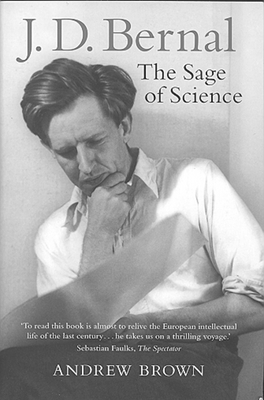The Sage of Science
Roy Johnston reviews J D Bernal: the sage of Science by Andrew Brown, Oxford University Press, ISBN 978 0 19 920565 3, £12.99 pbk

JOHN DESMOND Bernal (1901-1971) began as a physicist and crystallographer, but developed wide-ranging interests, stimulating the invention of the word 'polytropism' among his biographers.
The domains and issues to which he contributed robust critical writings include science in history, science and society, science and government, science in war and in peace, the peace dividend, the 'third world', development economics, also modelling complex systems in stochastic environments, which process eventually emerged under the label 'operational research'.
Bernal's primary scientific work in X-ray crystallography was dedicated to the understanding of the structures of proteins and viruses, the physical basis of life.
He was responsible for the development of the experimental technology which enabled Watson and Crick to solve the structure of DNA, an important link being the work of Rosalind Franklin (see Brenda Maddox, The Dark Lady of DNA, Harper-Collins, London 2002, in which there are many Bernal references). The author treats in depth, in one closely-argued scientific chapter, the details of Bernal's scientific career, which fuelled Nobel Prize work by Bragg, Blackett, Crick, Kendrew, Perutz, Watson, Wilkins and others, all of whom generously recognised Bernal's influence.
The bulk of the book however is taken up with the politics of 'science and society', which was dominated by the second world war and the cold war. Prior to the Second World War Bernal had established a reputation as a Marxist social critic; by sticking to internal British politics he managed to avoid the 'Soviet intelligence' route taken by his Cambridge colleagues Burgess, Maclean, Philby and Blunt.
Under pressure of the threat of war in 1938 he was recruited into civil defence work, analysing the effects of bombs, and was recruited during the war by Mountbatten into the planning of the Normandy landings, in the context of which the 'Operational Research' process was invented. For example, he managed by assembling quantitative evidence from a variety of improbable sources to evaluate the Normandy beaches as regards their ability to land heavy equipment, without direct access to them.
Bernal's role with Mountbatten was later challenged, in arguments which arose in the context of his obituary, by Bernal's sometime colleague Solly Zuckerman, who had subsequently fallen out with him.
The author in a postscript demolishes Zuckerman's arguments, which had influenced an earlier biographical attempt by Maurice Goldsmith. The latter was blacked by Bernal and his trustees, who went on to produce, after much delay, a more rounded omnibus biography, with contributions mostly by people who knew him (I got to do the 'Irish roots' chapter). This was published by Verso in 1999, edited by Brenda Swann and Francis Aprahamian.
Andrew Brown acknowledges this book as a valid contribution, but goes into much greater depth in all aspects of Berrnals polytropic existence, including his many women (designated disparagingly by Zuckerman as his 'widows' in the post-obituary controversies), most, if not all, of whom retained lasting respect for him.
The book is structured in a rough chronological framework, but switching between the various domains according as they acquire priority with Bernal, so that one sometimes get overlapping chronologies in different domains.
Most readers, being critical-minded scientists, will treat this as an interesting zig-saw puzzle which when fitted together will be seen to give a superb picture of a Renaissance character, of Leonardo da Vinci stature, spanning all aspects of human culture, and pioneering in modern times the resurrection of science as a key cultural component.
My own interest in Bernal goes back to my 1940s time in Trinity College Dublin, where I attempted to understand aspects of the 'science and development economics' domain in the context of left-wing politics in post-colonial Ireland, then stagnant and crippled by 'brain-drain'.
I discovered Bernal's 1939 book The Social Function of Science, and was hooked. Later in the mid-1960s I corresponded with Bernal when I was associated with a group of scientist and engineers lobbying the Government to take seriously the 1963 OECD Report ,em>Science and Irish Economic Development.
He replied with some good suggestions, though he was then in bad health. After he died I came across the unauthorised Goldsmith biography, read it critically, and found the Irish background material in it seriously deficent; this prompted me to research it, leading eventually to my chapter in the 1999 Verso book. (See also my own book Century of Endeavour, the Irish edition of which was published by Tyndall//Lilliput in April of this year, following a US edition by Academica in 2003. (An overview is available at the URL http://www.iol.ie/~rjtechne/blurb.htm)
Andrew Brown treats Bernal's early views on Soviet science, which were somewhat uncritical (for example he initially accepted Lysenko), without any whitewashing.
My own explanation is in terms of his Catholic background; I have observed cases where people abandon Catholicism for Marxism and remain in a similar mind-set, substituting Moscow for Rome. Bernal however managed to avoid the worst aspects of this syndrome; his later work in the peace movement during the Cold War undoubtedly contributed to the peaceful resolution of the Cuban missile crisis; he had a direct line to Khrushchev via the Soviet scientific establishment.
His work on the 'peace dividend' concept, pioneered in his book World Without War (London, 1958), deserves to be developed in greater depth, taking into account our current understanding of global warming and the fossil fuel crisis. Indeed, any scientific agency specialising in addressing the global warming problem, and promoting the necessary reorientation of the US government's policies relating to energy, could well be named the Bernal Institute! Roy Johnson's review originally appeared in
Roy Johnston's review originally appeared in Chemical Heritage News Magazine
Connolly Association, c/o RMT, Unity House, 39 Chalton Street, London, NW1 1JD
Copyright © 2007 Roy Johnston

